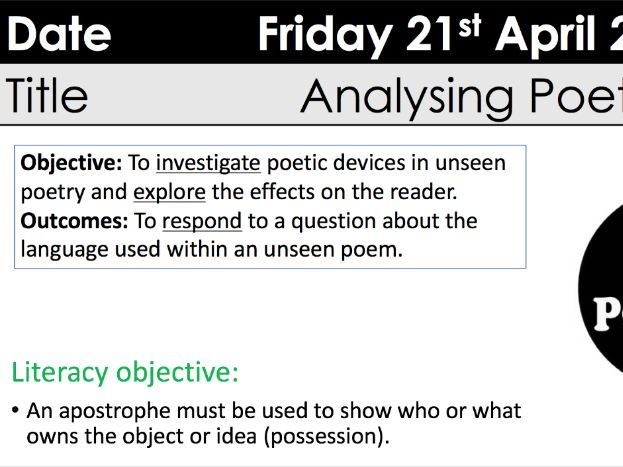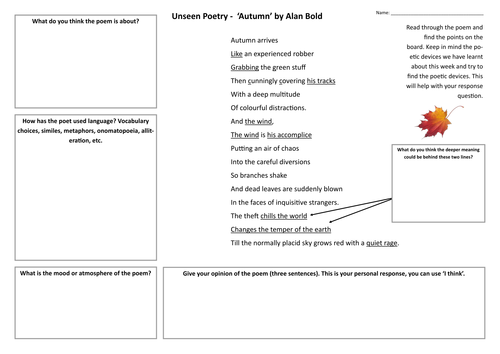




Objective: To investigate poetic devices in unseen poetry and explore the effects on the reader.
Outcomes: To respond to a question about the language used within an unseen poem.
Literacy objective:
An apostrophe must be used to show who or what owns the object or idea (possession).
Literacy objective starter task, and (this can be included if used with my previous GCSE Eduqas WJEC Intro to Poetry lesson) any extra time to complete the poetic device hunt. This slide can be removed, however.
Starter: What could 'SMILE' be? Structure, meaning, images, language, effect on reader. Handout to support and stick in books to refer back to.
Then pupils to read blind through the poem and think what is the poem about, share with partner and write their response around the poem. Repeated for the mood of the poem.
Pupils to then match-up poetic devices within the poem (some are underlined for differentiation support). Then pupils must find more content points.
Repeating think, partner, share to gather what might the effect be on the reader and if there is deeper meaning in any of the lines.
Model response to an analysis of two lines of the poem with a model paragraph. Pupils are to then follow by example and pick any two lines and write about the language to answer the question 'How is nature presented in Autumn?' for independent 10/15 time.
Plenary (post-its or in books): What have we learnt today/What would you like to improve on.
Get this resource as part of a bundle and save up to 61%
A bundle is a package of resources grouped together to teach a particular topic, or a series of lessons, in one place.
WJEC Eduqas poetry unseen and anthology with A3 sheets
This bundle is all of my poetry resources from my KS3/GCSE/A-Level lessons and includes all PPTs from the lessons too. It also has GCSE poetic device posters for your classroom or for a carousel activity, and chunks down poems using A3 sheets for analysis. Whole bundle would cost £28.00, save 63%
KS3/4 Poetry/Unseen Poetry bundle
A range of lessons and resources focused toward the Eduqas exam board but this can be changed easily or verbally in class. Differentiated activities/A3 sheets/chunking of tasks and challenge tasks included. This has worked well for all ranges and abilities, for extra challenge I would include a written exam question on the board for the most able also.
Something went wrong, please try again later.
Report this resourceto let us know if it violates our terms and conditions.
Our customer service team will review your report and will be in touch.